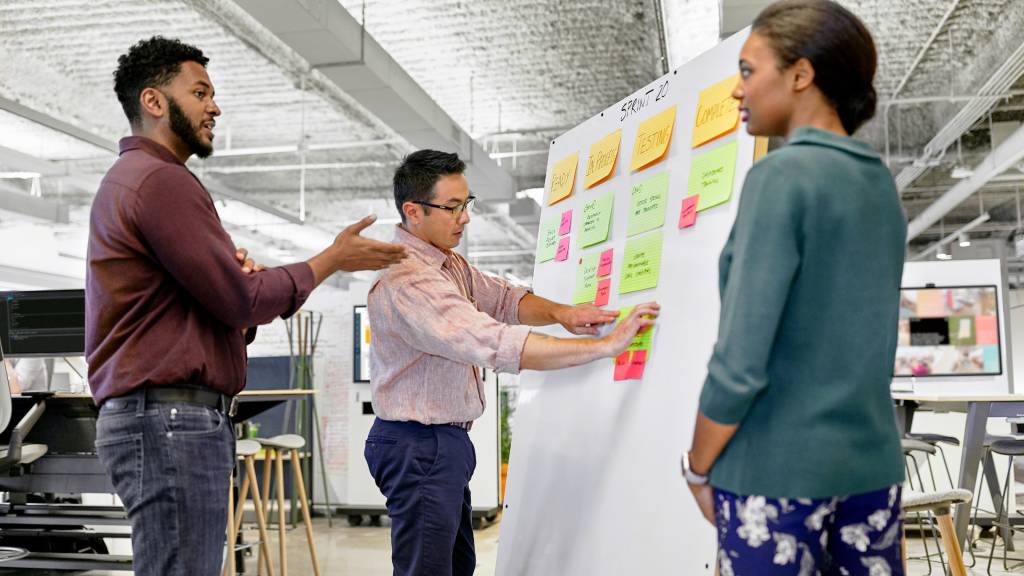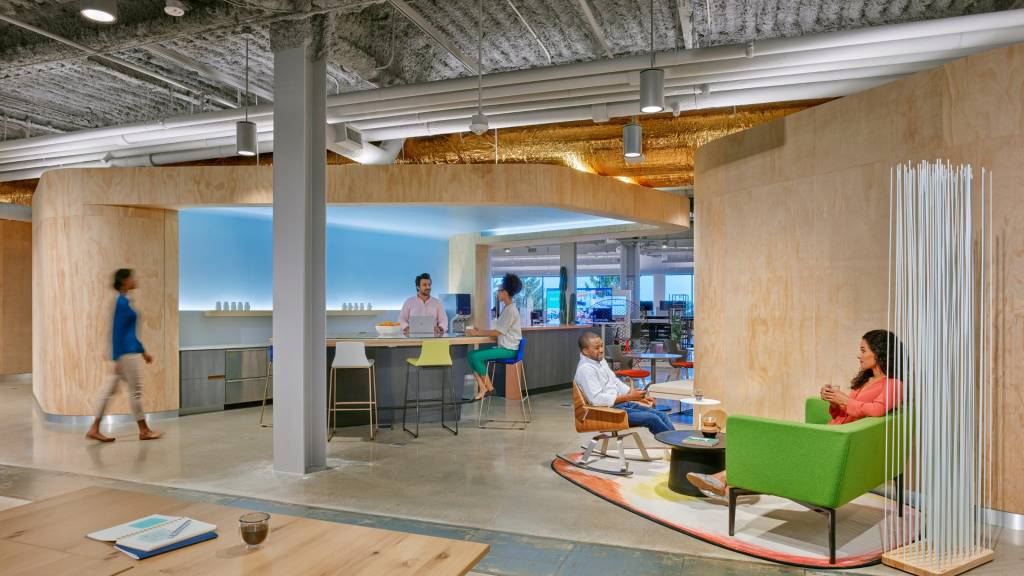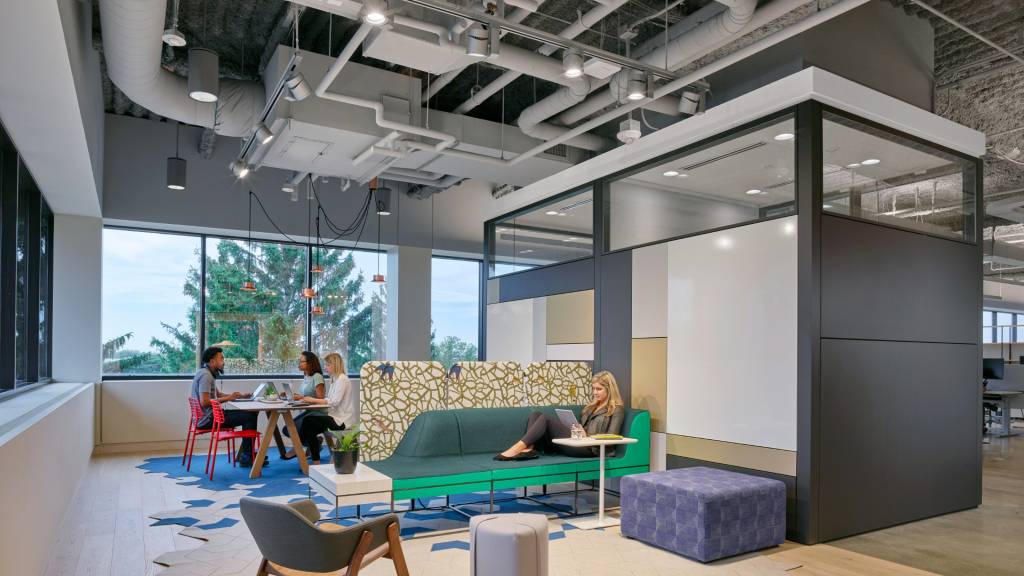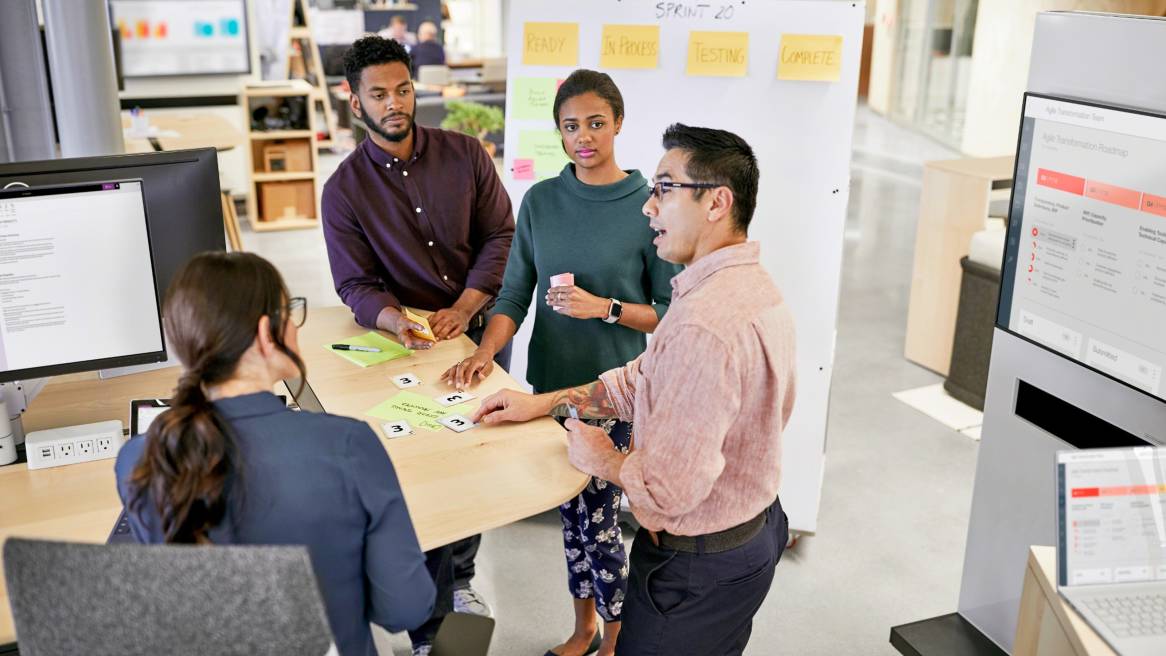Measuring the Agile Workplace
Why our new agile space won’t have a ribbon cutting
By Tracy Brower, Ph.D., MM, MCR
After creating our new space for Steelcase IT professionals in support of agile manifesto-based work, we didn’t have a ribbon cutting, and we don’t plan to. Of course, we’ve had plenty of celebration about the new space since our June 2018 move-in, but a ribbon cutting tends to imply a finish line and we are committed to ongoing learning and continuous improvement of the space—and hence no finish line. Agile is a journey and likewise, we want to sustain our great new space by continuing to learn how people work and how the workplace can be improved over time.
Our research efforts will continue, but we’re excited about our early findings. For example, velocity has increased by 36%, trust has increased (in particular, 9% fewer people are concerned about misunderstandings among colleagues as compared to their reports prior to the spatial changes) and 18% fewer people are concerned about access to equipment and tools. We’ll share more on our complete results later in this article, but first, here’s more on our process toward learning and research.

As our results suggest, our transformation hasn’t only been about the space, it has also included efforts toward shifting the culture and the process as well. We’ve taken a holistic approach with an overall goal of IT seeking to become a better partner to the business and to become more strategic within the context of overall digital transformation.
Measurement planning
Our journey to measure results began at the same time we started to plan for shifts in culture, process, and place. Led by our WorkSpace Futures and Applied Research + Consulting (ARC) groups in collaboration, we began with the overall goal (become a better partner to the business) and embraced the IT guiding principles—particularly the primary importance of the customer needs and the importance of succeeding as a team—as our true north. We identified the behavioral attributes of the principles—what would we see people doing and hear them saying if the principles were taking hold. Once we had clarified the behaviors, we identified the ways it would be possible to measure them and then prioritized based on the effort they would take and the impact they would have. Ultimately, we established plans to measure results that were both qualitative and quantitative and that included measurement activities before the change and after the change, and on an ongoing basis so we could compare results over time.
Importance of engagement

In addition to the value of measurement in demonstrating results, it has also been important to the process of engaging people in the change. Our IT staff reports they feel like the change wasn’t done to them but with them. The methods of prototyping, asking questions, seeking input, and discovering more about key elements of the work provide for key ‘pre’ information to compare with ‘post’ experiences, but also involves people in the process. (Learn more about our overall change management efforts here.)
Ultimately, we mined multiple sources of data to arrive at our initial findings: from workshops and focus groups to interviews and observation data and from surveys and project management data to Workplace Advisor and Microsoft Analytics data. One caveat: We completed a wide swath of research efforts which was right for our purposes. You don’t necessarily have to do as much in order to have a compelling measurement approach. We recommend completing the amount of measurement that is right for your unique situation—enough to demonstrate results and inform improvements while also taking into consideration the resources necessary to support the measurement efforts.
Early findings
In addition to the changes in culture and process, spatial changes have been significant with the design based on urban planning which include neighborhoods, a business district, a town square and garden areas for both collaborative and individual work. This approach was a platform to host the shifts in both process and culture. The results below demonstrate the shifts following the transition to the new space, and were measured approximately 3-5 months following our June 2018 move-in:
Agile Work
We’ve found the agile mindset is embedding and taking hold. The best evidence of this has been an increase in velocity—an agile measure of the amount of work completed during each sprint (cycle of work). To-date, velocity has increased 36%.
Residency and Fluidity
People are working together and connecting in new ways supported by choice, privacy and places for rejuvenation. In particular:
- Over 80% of people agree they have increased choices for where to work.
- 17% more people strongly agree they can meet informally.
- 9% more people report access to privacy.
- More people also report the space supports them in reenergizing, and a greater number of people are having informal meetings and say they have access to team members. The space promotes teamwork within neighborhoods, combining mobile and resident workers within a ‘home for a team’, providing access to teammates and to shared tools and assets.
- Interestingly, we see a greater usage and efficiency of large conference rooms compared to the rest of campus and compared to our customers. Teams are gathering together in larger spaces when they need to do work outside their studios—this supports our early insight about the importance of treating the team as the unit in an agile environment.
- Unique to this space as compared to the rest of our campus and to our customers’ experience, we’re also seeing lower usage of smaller conference rooms. This is because teams tend to use their studio spaces for one-on-one and small group meetings—exactly what we had hoped in the design of the space to support agile work.
Boundary Spanning
Boundary spanning—the process of linking people, teams, networks and sources of information—has been increasingly supported through the changes in place, process and culture.
- Trust has increased, evidenced through 9% fewer people reporting they have concerns about misunderstandings between colleagues.
- People report the space helps them perform better and contributes to them feeling valued by the organization.
- The space is increasingly being used as a tool in the recruiting process—with HR touring potential new hires through the space on a regular basis.
Community and Learning
We are building community and networks and taking an intentional approach to change management.
- Increasing numbers of people report they come to the office in order to participate with their teams and build networks.
- More customers are present within the space—supporting a key tenet of agile work in which customers are embedded and feedback cycles with customers are key to success.
- People report change management efforts have helped them feel supported and engaged through the transition.
Leadership and Strategic Visibility
Leadership is shifting—becoming more empowered and empowering—and people say they are more connected with the big picture, having greater line-of-sight from their work to the ultimate goals of the department and the organization.
- Leaders are more present and accessible, and information is transparent and shared with more immediacy than before the changes.
- Leaders are having more one-on-one meetings with their staff members and focusing on development during those sessions.
- People say they are experiencing a greater connection to strategy and purpose.
- More meetings are occurring between IT staff members and those outside the department and outside the company.
Social Infrastructure and Information Architecture
The space is supporting information access in new ways.
- More people report they have access to the necessary technology and 8% more people report they have the right technology to connect with others outside of the office.
- 18% fewer people are concerned about access to the right equipment and tools.
- 9% more people report they can quickly access information.
Overall, we’re seeing a wide range of positive changes related to the culture, process and spatial changes we’ve implemented, and we will continue to iterate and measure the impacts of our changes.

Continuous learning + improvement
However, while we’re enthusiastic about these results, we don’t have everything figured out, and we are always learning. For example, we are working to clarify norms for certain areas of the agile studios since teams had questions about who could use elements of the neighborhood space. In addition, we’re continually seeking ways to increase visual display and the amount of information available within the space. We’re also working to balance the need for teams to meet in their spaces and include their remote colleagues while managing the acoustical challenges that come along with this need. Our opportunities to learn continuously and improve ongoing, reinforce the nature of agile where learning and incremental improvements are foundational. We will continue to share what we’ve learned.
While we don’t have any plans for a ribbon cutting event, we are celebrating our success and our outcomes. At the same time, we are working to learn and improve, knowing that the journey continues, and we’ll always need to respond to the changing nature of work and the needs of workers with high-performing and flexible workplaces.

Dr. Tracy Brower is a sociologist focused on work, workers, and workplace. She is a Principal with the Applied Research + Consulting group at Steelcase and the author of Bring Work to Life by Bringing Life to Work: A Guide for Leaders and Organizations (2014). Tracy contributes as a board member with the IFMA Research & Benchmarking Institute as well as an executive advisor for Coda Societies and for Michigan State University’s Graduate Mathematics Program.


